#skeletal reconstruction
Text

Skeletal reconstruction of Sauropelta edwardsorum, the nodosaurid dinosaur which lived 108.8 million years ago in the Early Cretaceous of what is now Wyoming, Montana, and Utah
#dinosaur#dinosaurs#skeletal#skeletal reconstruction#paleontography#paleontology#paleoart#sauropelta#nodosaur#thyreophora
208 notes
·
View notes
Text
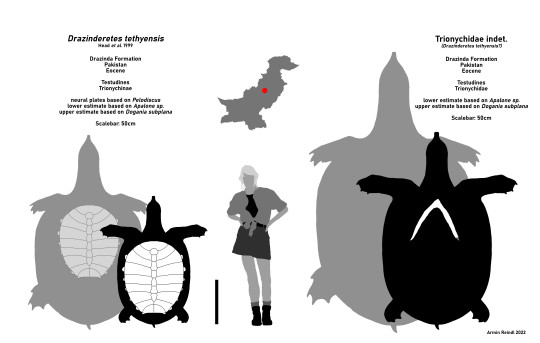
Back to older art. These are giant softshell turtles found in the Eocene Drazinda Formation of Pakistan. On the left is Drazinderetes (Greek for Drazinda Rower), known from a bony carapace 0.8 meters long. On the right, an indetermined softshell turtle that may or may not belong to the same species, but is only known from a plastron element. This might correspond to a bony shell 1.2 meters long. As you can see there are some big difference between the lower estimate and the upper estimate, which has a lot of free space. This is because in different softshell turtles there's difference ratios between the bony and the soft shell parts. The lower estimate is based on Apalone softshell turtles, which have only 20% cartilage on the shell, while the upper is based on the Malayan softshell which has up to 45% cartilage in addition to the bone.
First image Apalone ferox (Florida softshell) by Johnskate17 on Wikimedia
Second image Dogania subplana (Malayan softshell) by Wibowo Djatmiko on Wikimedia

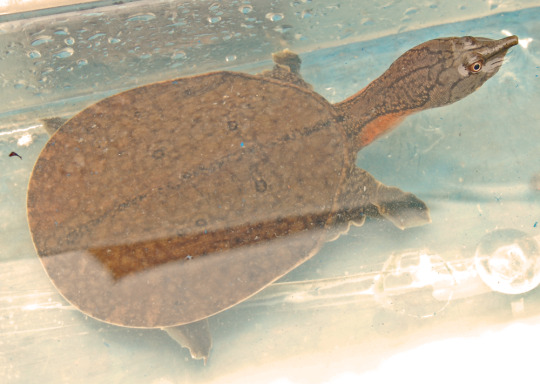
Drazinderetes lived during the Eocene in what is now Pakistan in the Drazinda Formation. This is interesting as this formation preserves a marine environment, meaning that in the absence of evidence that the fossils were washed out at sea, Drazinderetes might have been a marine animal. This would match its enormous size, as most giant turtle species have been marine (not counting those of Miocene South America). Although this would make it the first known fully marine softshell until evidence of the contrary is found, modern softshells are known to occasionally enter saltwater. Drazinderetes shared its environment with crocodiles similar to Asiatosuchus, early manatee relatives in the form of Protosiren and primitive whales related to Basilosaurus. The following reconstructions have both been made by @knuppitalism-with-ue during his paleoart streams.
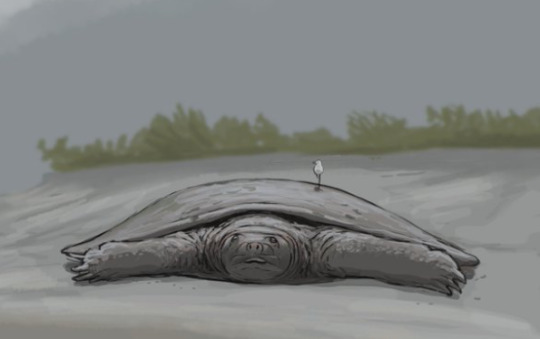
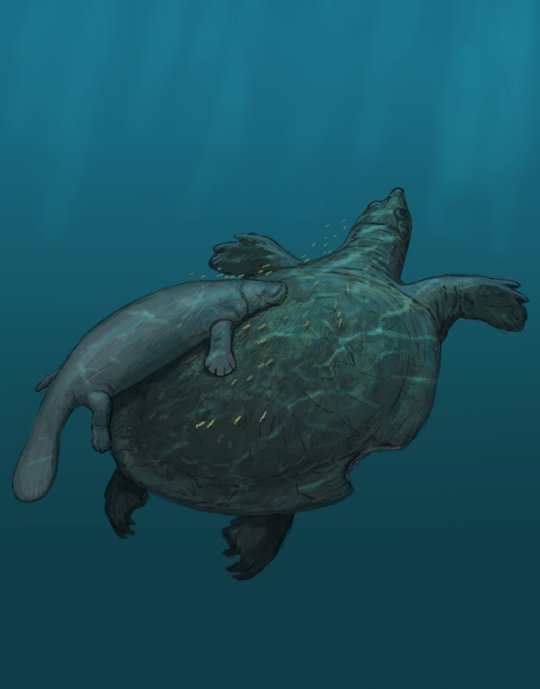
#drazinderetes#softshell turtle#eocene#palaeoblr#paleontology#turtle#drazinda formation#pakistan#skeletal reconstruction#skeletal#size comparison#palaeontology#big fucking turtle
344 notes
·
View notes
Text
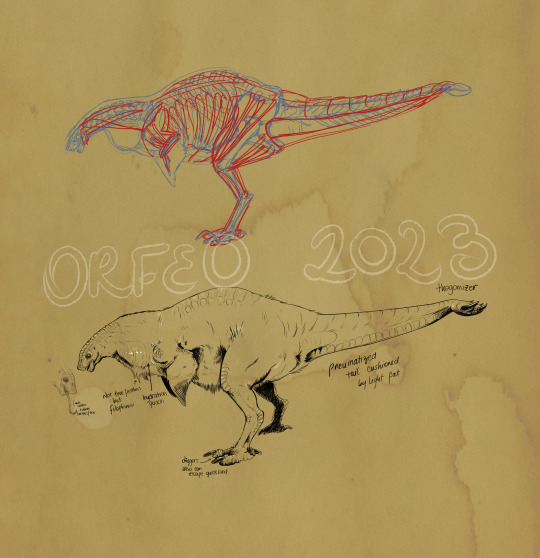


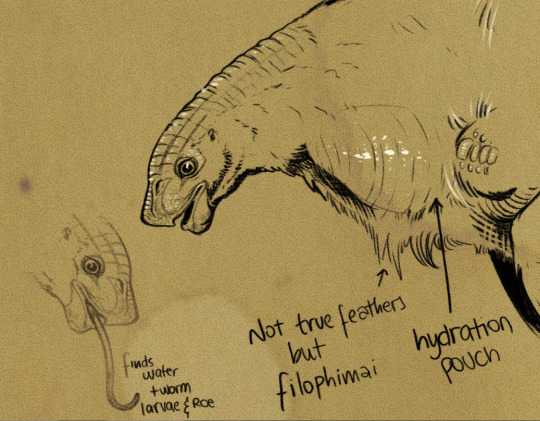
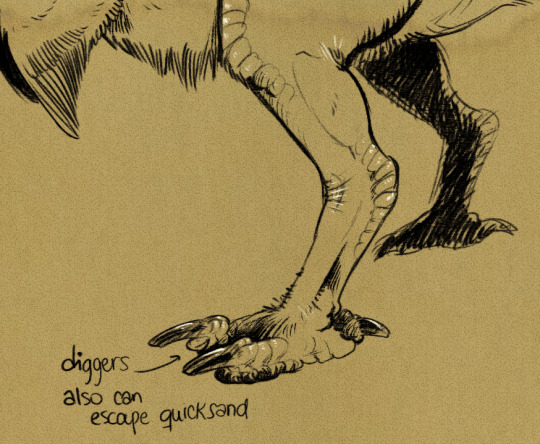

the thomas. Tomas. Tomasitos..... lil thomii??? these guys make me sooo happy jbdfhsdfgsg
#trigun#trigun maximum#trimax#trigun stampede#tristamp#thomas#speculative evolution#speculative biology#creature design#skeletal reconstruction#fantasy beast#fantasy art#orfeoarte
101 notes
·
View notes
Text
Taking a shot in the dark here but does anyone know where I can find 3d models of (dinosaur) skeletal reconstructions? I've found a couple on Cults3D and I've tried MorphoSource but I'm having a rough time using the search features on the latter :/
2 notes
·
View notes
Text

Neuquensaurus australis
by GetAwayTrike
The measurement is 1 metre, which is 3.3ft.
17 notes
·
View notes
Text
i entirely lost the plot while planning a response to a question and ended up on a sidetrack about the most recent common ancestor of the fox pokemon (genus Vulpes). Vulpes are the true foxes, though some other pokemon (like eevee) are colloquially called foxes they aren't as closely related to these guys. this tree is based on what we know from genetic evidence of the surviving members of the genus!


this little guy is Vulpes cinus, the earliest-known fox pokemon we've found, from 8 or so million years ago. it's only known from skeletal remains and we don't have enough material to revive it like some other fossil pokemon, so this reconstruction is entirely hypothetical! we do know that it was most likely a fire type based on its bones, though.
#pkmn#art#vulpix#nickit#zorua#fennekin#unreality#it doesnt have a proper common name (like 'zorua' or 'fennekin') so you get the scientific moniker.#a friend suggested calling it kitdarra which i like so much
4K notes
·
View notes
Text

April Fools 2024: The Curious Case Of The Chunky-Necked Ceratopsians
Much like the aquatic Compsognathus featured here a couple of years ago, not every novel idea that came out of the Dinosaur Renaissance was a winner.
And one of the oddest examples came from author/illustrator John C. McLoughlin.
His 1979 book Archosauria: A New Look at the Old Dinosaur featured an unusual interpretation of ceratopsian dinosaurs' characteristic bony frills, proposing that they were actually muscle attachment sites for both powerful jaw muscles and enormous back muscles to help hold up their large heavy heads. This would have completely buried the frill under soft tissue, giving the animals massive thick necks and humped shoulders, and resulted in an especially weird reconstruction of Triceratops with a grotesque sort of wrinkly sewn-together appearance.
This concept didn't entirely originate from McLoughlin – three years earlier in 1976 he'd illustrated Ronald Paul Ratkevich's book Dinosaurs of the Southwest, which seems to have been the inspiration for Archosauria's fleshy-frilled ceratopsians. A few paleontologists had also proposed jaw muscles attaching onto the frills during the 1930s and 1950s, and there's even a book from as far back as 1915 that also shows the top of a Triceratops' frill connected to its back! But McLoughlin's Archosauria image is still by far the most extreme and infamous version of the idea.
There were a lot of things in Archosauria that were actually very forward-thinking for the time period, such as putting fuzz and feathers on small theropods and depicting non-avian dinosaurs as active fast-moving animals. The unique ceratopsian reconstructions, however, never caught on for several big reasons:
Firstly, all that hefty muscle tissue would have locked ceratopsians' heads firmly in place, unable to move at all, which just doesn't make sense biomechanically. Then there was the lack of skeletal evidence – muscles that big should have left huge visible attachment scars all over the frill bones, and there was no sign of anything like that on any fossil specimens. Finally, it turns out the ceratopsian head-neck joint was actually highly mobile, suggesting their heads were free to make a wide range of motions in life.
As wrong as they were even at the time, McLoughlin's ceratopsians were still an interesting speculative idea, and notable for advocating for fleshier dinosaur reconstructions at a time when paleoart was trending towards shrinkwrapping.
Further reading under the cut:
A Very Alternative View of Horned Dinosaur Anatomy, Revisited – https://tetzoo.com/blog/2020/11/22/alternative-view-of-horned-dinosaur-anatomy
Trope of the Buffalo-Backed Dinosaur – https://tetzoo.com/blog/2020/11/27/trope-of-the-buffalo-backed-dinosaur
Vintage Dinosaur Art: Archosauria - Part 3 – https://chasmosaurs.blogspot.com/2013/10/vintage-dinosaur-art-archosauria-part-3.html
Vintage Dinosaur Art: Dinosaurs of the Southwest – https://chasmosaurs.blogspot.com/2016/11/vintage-dinosaur-art-dinosaurs-of.html
The Forgotten John C. McLoughlin Book – https://www.manospondylus.com/2021/03/the-forgotten-john-c-mcloughlin-book.html
#april fools#inaccurate paleoart#retrosaurs#science illustration#paleontology#paleoart#palaeoblr#triceratops#ceratopsian#dinosaur#art#mcloughlin ceratopsians#they are very shaped#she's beauty she's grace she can't even turn her face
311 notes
·
View notes
Text

Here, again, my idea for Thyreosaurus. I had a lot of fun speculating about the appearance of this one. It has some crazy osteoderms that aren't like anything we see in stegosaur otherwise.
The big questions were: how were these positioned? Were they homologous to the plates? If not, did these replace them or did they have a complete different position and function?

One of the most interesting feature for me is that these plates seem to be concave, so they likely formed shallow depressions on the animal; a fun idea. Here my first impression sketch, just an hour after the paper came out.

The version I did on the stream differs slightly, with a more fluent transition from hip to tail plates. The partial skeletal reconstruction by @SlvrHwk_paleo (on Twitter) helped a lot.
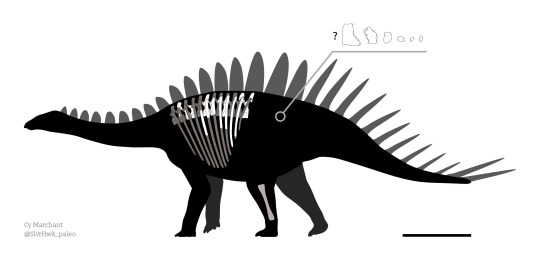
I should say that this interpretation of the animal is totally subjective, it could be way more conventional or way weirder. I hope people continue to experiment with it and I hope more excavations will bring more of this material to light. Don't take my work as gospel.
Also: THIS IS NO APRILS'S FOOL JOKE
#paleoart#sciart#paleostream#palaeoblr#jurassic#morocco#thyreosaurus#dinosaur#stegosaur#animals#sketch
203 notes
·
View notes
Text

Skeletals of two Dacentrurid stegosaurs that both hail from the El Mers lll Formation of Morocco 168-160 million years ago and were both described within four years of each other, from bottom to top: Adratiklit boulahfa and Thyreosaurus atlasicus.
#paleoart#dinosaur#dinosaurs#stegosaur#stegosaurs#thyreosaurus#thyreophora#skeletal reconstruction#skeletal#skeletals#skeletal reconstructions#paleontology
52 notes
·
View notes
Text

Duerosuchus is a rather small crocodilian from the Eocene of Spain. When initially described it was placed closely to the clade Brevirostres (Gators and Crocs), but a later phylogenetic analysis found out that it was actually a member of the Planocraniidae.
Planocraniidae is a family of terrestrial crocodilians (or more basal Eusuchians) that lived in Eurasia and America during the Paleocene and Eocene. The family also includes the much larger Boverisuchus magniforns from Germany and Boverisuchus vorax from America, as well as Planocrania from China. Effectively speaking, Boverisuchus is the animal previously known as Pristichampsus, because Pristichampsus was based on fragmentary material that wasn't diagnostic enough. So out with the old, in with the new.
Planocraniids were one of multiple groups of crocodiles inhabiting the Eocene rainforests, adapted to a more running lifestyle with toes tipped by hooves and later ziphodont (compressed and serrated) teeth. At least in Boverisuchus. The teeth of Duerosuchus and Planocrania were already flattened, but not serrated. The other three prominent croc groups in the Eocene jungles of the northern hemisphere were crocodiles, represented by "Asiatosuchus" in Spain, alligatoroids, present with Diplocynodon, and Sebecids, a group thats much more ancient and not part of the crown group of crocodiles. Sebecids are present with Iberosuchus, another terrestrial hunter, but one that was much larger than Duerosuchus. (bottom image by Ortega et al.)
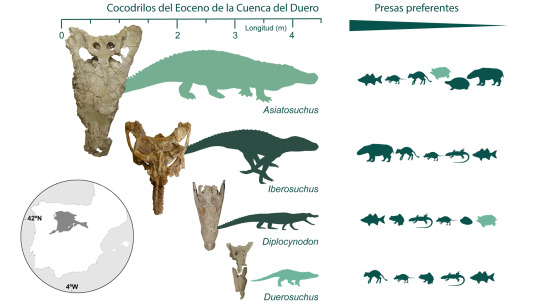
#duerosuchus#planocraniidae#boverisuchus#planocrania#pristichampsus#eocene#paleontology#palaeoblr#spain#duero basin#skeletal reconstruction#steven irwin for scale#crocodiles#prehistory
106 notes
·
View notes
Note
hi so i’ve been following you for a little (mostly because of dinosaurs and mechanisms) but i’ve been curious about this and don’t really know where else to ask, how do you find dinosaur references? i’ve been wanting to start drawing some dinos again but really have no idea where to go for references or inspiration.
my go-to's are skeletal references and 3d models!
for skeletals, the gold standard is scott hartman's. he's done sooo many and they're all very good- you can find them on his website here. https://www.skeletaldrawing.com/

i do think his life reconstructions tend to be on the shrinkwrapped side, but his skeletals are great.
for skeletals, gregory s. paul is another great resource. if you can find a physical or digital copy of the princeton field guide to dinosaurs, it has skeletal references for a LOOOOT of dinos.
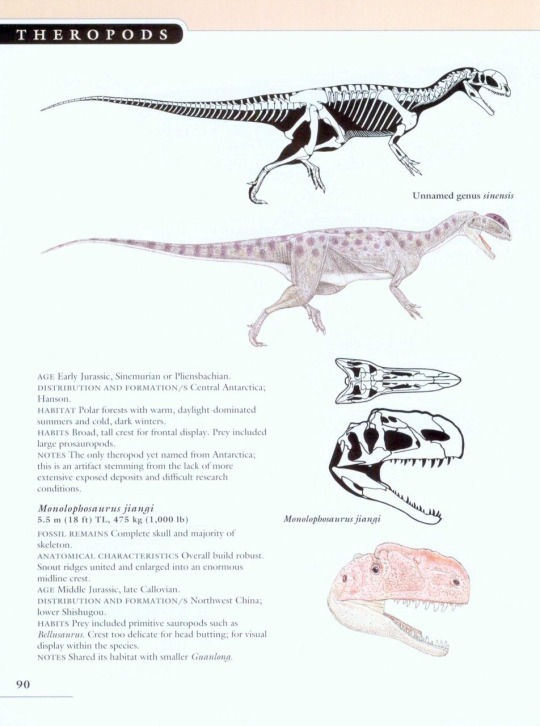
greg paul's life reconstructions should also be taken with a grain of salt- shrinkwrapping and pronated hands abound. his taxonomy is also notably controversial (he's the lead author on that tyrannosaurus regina/rex/imperator paper from a while back..), so double-check the genus/species names you're referencing.
(he also has the princeton field guides to marine reptiles and pterosaurs, but i haven't read those so i can't comment. haven't heard great things about the pterosaurs one, though- if you want pterosaur references, go for pteros.com, pterosaur.net, and mark witton's "pterosaurs" book)
now for 3d models- skeletals are all well and good, but if you're not drawing a dinosaur from the side their usefulness can be limited. sketchfab is my go-to to find 3d reference. i look for skeletons/skulls from museums that have been digitized, mostly-

but i'll also look for full reconstructions, just reference them in the same way you'd reference any other art piece (with care).
i also sometimes use the video games saurian and prehistoric kingdom? they both allow you to spin around the models of their animals, and their reconstructions are both super good.
lastly is to reference the work of other palaeoartists! this especially fits in for the inspiration part.
here's a few awesome palaeoartists around the internet (tyhank you to billymayslesbian for helping me put these together!)
mark witton

fred wierum (aka fredthedinosaurman)
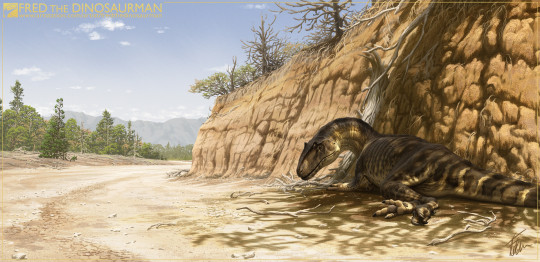
john conway

alphynix (here on tumblr under the same name)
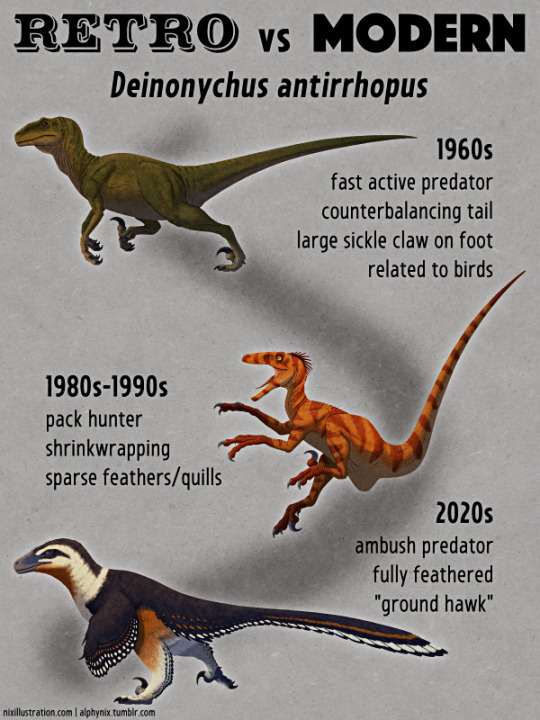
julio lacerda (this hatzegopteryx image is one of my favorite palaeoarts ever tbh)

joschua knüppe (here on tumblr at knuppitalism-with-ue, i'm especially a fan of his work recreating classical paintings with extinct primates)

and for more cartoony/styilized work:
miquel camiodraws
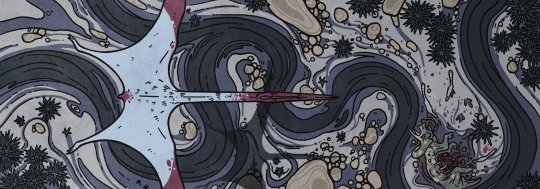
johan egerkrans

abby howard (here on tumblr at abby-howard)

natalia jagielska

greer stothers (here on tumblr at pangur-and-grim)
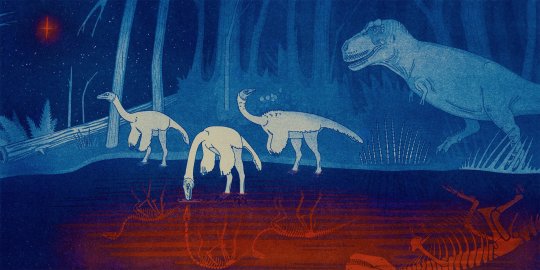
nev (saint-nevermore here on tumblr, this picture is one of my favorite palaeoarts of all time)

for some more books, check out all yesterdays by darren naish and john conway, which takes a highly speculative look at reconstructions of prehistoric animals, mostly dinosaurs.
also look at mark witton's the palaeoartist's handbook, which is exactly what it sounds like and i think could be VERY helpful for what you're looking for.
61 notes
·
View notes
Note
What do you think about the walking with dinosaur trex? As a kid I always thought the head looked really boxy, it looks very distinct from other trexes I’ve seen around.
Walking With Dinosaurs Tyrannosaurus is,,,, Bad
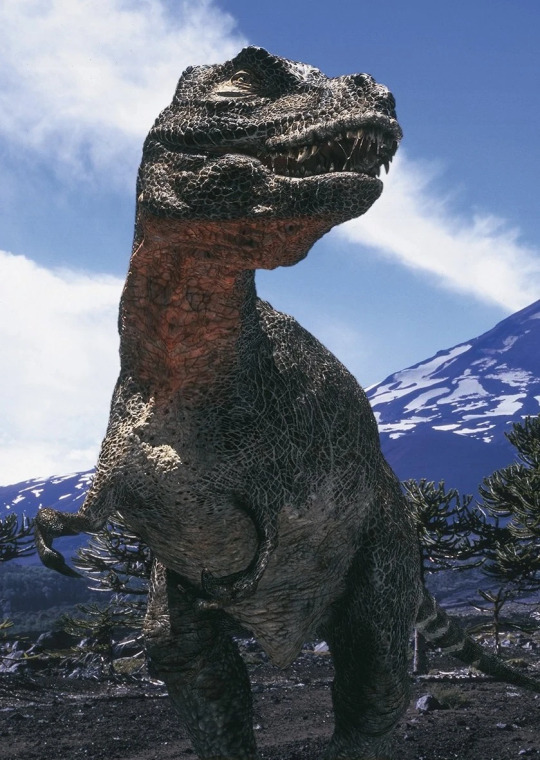
I'm not sure what it is about WWD and large theropods but both the Tyrannosaurus and Allosaurus look really Weird, especially in the head. Allosaurus's horns got placed directly over its eyes, and the whole shape of the head is really triangular.
With the Tyrannosaurus, the head is just. a Block.
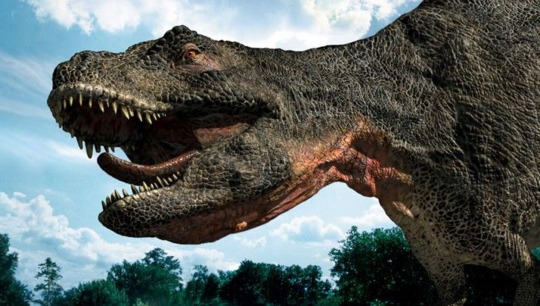
Proportionally it's shorter and thicker than a real Tyrannosaurus skull, and while the shape of the lower jaw is actually pretty close the back of the skull is where issues really start to crop up.
They've ticked all the boxes in the abstract: big brow ridges, wide back of the skull, heavy lower jaw. But the execution of them really falls flat. Mark Witton's reconstruction from the recent theropod lips paper actually makes a very good comparison here since it's almost at the same angle:

The body itself is oddly proportioned too, with very long legs, and shorter thinner tail, long arms, and a thin neck. Overlaying Scott Hartman's Tyrannosaurus skeletal over the top of it really brings out the Weirdness

In some areas, like with all of WWD, the inaccuracies here are due to Science Marching On (the lack of lips and the shallower torso due to differently-reconstructed gastralia). But most of the problems with how the head is shaped were just at inaccurate in 1999 as they are now, and it's a little baffling to me how such a famous and well-studied dinosaur ended up looking so... Off?
On the other hand, the actual behaviour of the Tyrannosaurus is fantastically naturalistic, and the colour pattern is very appealing and absolutely iconic. It's just kind of a shame that it got combined with this odd, lumpy anatomy
335 notes
·
View notes
Text

Skeletal reconstruction of Crocodylus thorbjarnarsoni. This is one of my older stuff, I will update it anytime soon.
87 notes
·
View notes
Text
A heavyweight early whale pushes the boundaries of vertebrate morphology
Published 2nd August 2023
Discovery of a new basilosaurid whale, Perucetus colossus, estimated to have the highest degree of bone mass increase known to date - implies Possibly the heaviest animal ever discovered; Perucetus colossus is known from partial postcranial remains of the middle Eocene epoch in Peru.

Skeletal reconstruction and size compared to human

Artist reconstruction of Perucetus colossus, by A. Gennari
Source:
https://doi.org/10.1038/s41586-023-06381-1
133 notes
·
View notes
Text

Extravagant Bead Necklace from Neolithic Child’s Grave Reassembled
An elaborate necklace of thousands of beads discovered in a child’s grave in the Neolithic village of Ba’ja, southern Jordan, has been reassembled bead by bead five years after it was unearthed. It is the most elaborate adornment ever found at a Neolithic site, and is a unique testament to the funerary practices of the elite in this prehistoric farming and livestock-raising community.
Located not far from the Nabatean rock-cut city of Petra, Ba’ja was occupied between around 7,400 and 6,800 B.C. It is densely packed with multi-layered stone dwellings that are believed to have been homes and stores for family units. While the deceased were usually buried elsewhere, some of the dead were buried in individual, double or collective graves underneath the structures.
In the summer of 2018, a stone-lined cist grave was found underneath the floor of a stone house. It contained the skeletal remains of a child about eight years old buried in fetal position. While the sex could not be conclusively determined, the shape of the chin suggests the child was female. The archaeological team named her Jamila (meaning “beautiful” in Arabic).
The skeleton was in a very poor state of preservation with bones missing and severely damaged by thousands of years and the heavy weight of the layers above the grave. Excavation revealed concentrations of beads of various materials and sizes mostly grouped around the child’s chest and neck. An astonishing 2,500 beads — flat beads, cylindrical beads, disc beads, tubular shell beads — were ultimately unearthed. Most of them were made of sandstone, but there were also turquoise, shell and amber beads from Lebanon that are the oldest ever discovered.
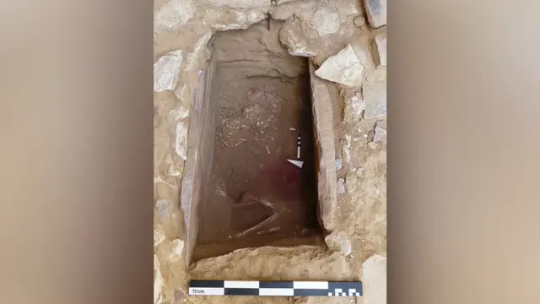
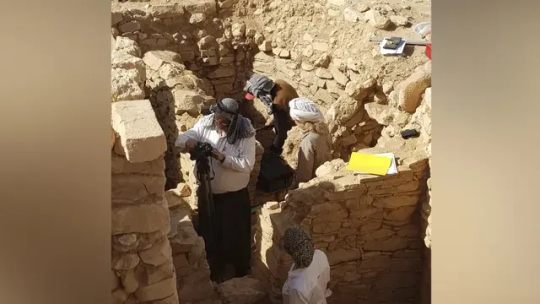
The bead concentrations were distributed between two large pendants: a mother-of-pearl ring carved from a large single pearl oyster shell with multiple perforations and a double-perforated oval hematite pendant. The mother-of-pearl is particularly spectacular, and cannot have been local. It was likely an import from the Red Sea more than 700 miles away.
Some of the beads were found still aligned in several rows on the left side (the child was positioned on her left side and gravity did the rest) but many were scattered. Repeated patterns and combinations of bead type and color in the surviving rows indicate the beads cannot have been scattered over the body, but it was not clear whether they were originally part of a necklace, a decorated garment, chest piece or something else entirely.
The grave was documented in painstaking detail, and the concentrations and surviving rows made it possible for researchers to reconstruct the original configuration. The entire assemblage was loaned to research laboratories in Germany and France for cleaning, consolidation, restoration and analysis.
The result of the reconstruction is nothing short of spectacular, 12 inches wide at the widest point and 12 inches long at its longest. The most plausible arrangement for all those beads and pendants turned out to be ten rows, seven connected to each side of the mother-of-pearl ring and 3 separated from it.
The reconstructed necklace (with black foam placeholders for the beads that are too fragile to be integrated) is now on display at the Museum of Petra.
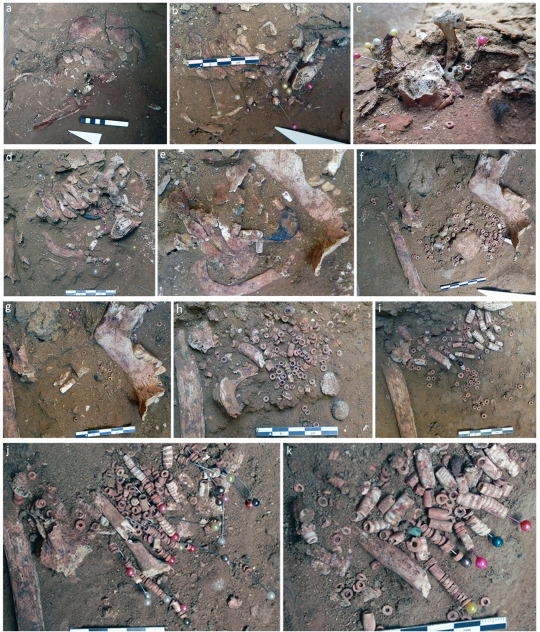
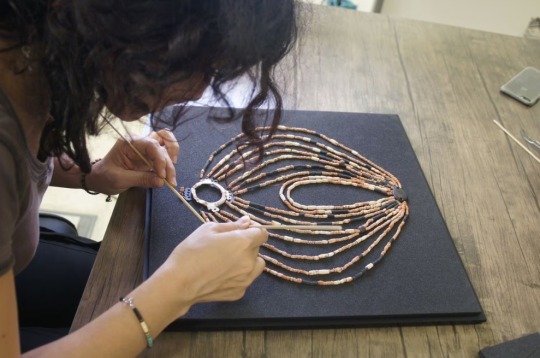
#Extravagant Bead Necklace from Neolithic Child’s Grave Reassembled#ancient grave#ancient tomb#ancient necklace#ancient jewelry#ancient artifacts#archeology#archeolgst#history#history news#ancient history#ancient culture#ancient civilizations
104 notes
·
View notes
Text
Mezzo - 04 - Peace in the Riot
Pairing: mshenko | Rating: M
Tags: Canon-typical violence, trauma, dealing with your problems poorly, body autonomy struggles
Summary: The twists and turns of ME2, through the eyes of everyone but Commander Shepard.
Chapter Summary: Shepard’s not dead and it’s everyone’s problem.
Thank you to @sinvraal for betaing!
Chapter 4: Peace in the Riot | Read on Ao3
30 October 2185, Omega Nebula, Sahrabarik System – Omega Approach, Normandy SR-2
Synthetic skin fibers. Skeletal-reinforcing bone weave. Muscle-perforating microfibers. Biomeimetic eyes with nanowire retinas. Biosynthetically fused spinal cord. The more Karin Chakwas learns about Shepard’s reconstruction, the more miraculous – and overwhelming – it becomes.
How did they do this?
Perhaps what distresses her most is the depth of repairs that had to be made. Lumbar burst fractures. Exposure to hard vacuum. Clinical brain death due to asphyxiation.
Shepard’s death hadn’t been slow, but it certainly had not been quick.
Knowing that his death had been all but certain the moment Moreau’s escape pod closed without him – that Alenko’s dedicated but fruitless search had indeed been in vain – somehow is not a comfort. Not when the Lazarus data makes it hard to deny the likelihood that he had lived long enough to know what his fate would be.
But the intel had been true. Cerberus had reneged his death.
She could study the Lazarus records alone for years. It will be studied for years, if she can get a copy of it into the right hands. But research is not why she’s here.
She thumbs through the drug pack stores with a furrowed brow. “EDI, who do I speak to about requisitions?”
“What is it you need, Doctor?”
A uniform without a Cerberus logo, for starters, and a manual on caring for a patient who’s come back from the dead.
“More glucagon drug packs and electrolyte tablets. This is hardly enough for one biotic, much less three.”
“I will see to it crewman Hawthorne is made aware.”
“Thank you. That’s most kind.”
“Is there anything else you require?”
“I’ll let you know.”
The fact that serving on a ship integrated with an AI is so far down the list of her troubles it doesn’t bear worrying about should bother her more than it does. But she does indeed have far more pressing concerns, chief among them, the person walking into her medbay.
“Commander,” she says warmly when the doors swish open and Shepard enters. “You came.”
He nods at her and takes a seat on one of the biobeds, trepidation on his face. “I said I would. And…I had some questions.”
The scarring on his face is the most visible sign of his resurrection. Looking beyond the fissures that glow a pale red, he is exactly as she remembers, with no trace of the two years she’s lived in the meantime. He isn’t the only one with questions. Some of hers she may never get the answer to.
“Ask away.”
Sam Shepard has always had the mind of a surgeon, knowing exactly where and when to cut to get what he wants, so she prepares herself for a question, or a barrage of questions, that puts her to the test. But instead of ask her anything he sits in silence, expression empty, curl in his back. The outline of one of the spinal clamps shows through his shirt.
She hands him a cotton swab to use on the inside of his cheek. Dutifully, he gives it back when he’s done, surely recognizing the reason behind it. There is belief in what she is seeing, and there is supporting it with irrefutable DNA evidence.
Once she plugs the sample in to be analyzed, she picks up the medical scanner and hums an old song her mother used to sing when she was a girl. She’d always found it soothing.
When she reaches the chorus a second time, he speaks up at last, voice soft.
“What happened?”
Read from the beginning | Read the rest on Ao3 | The Mezzo Playlist
#mass effect#mshenko#karin chakwas#kaidan alenko#mezzo!update#this chapter has one of my favorite scenes oh boy oh boy
43 notes
·
View notes